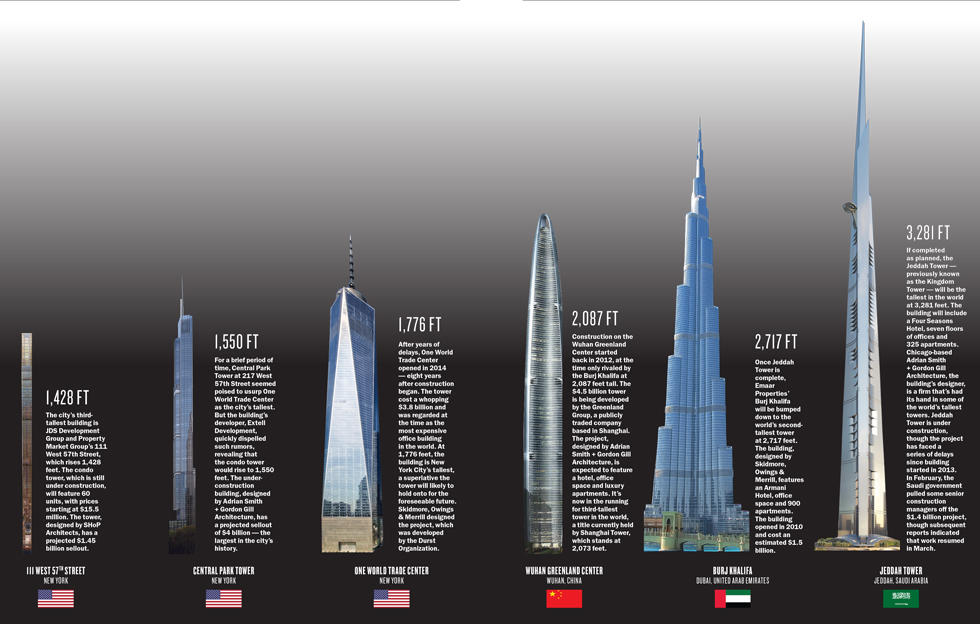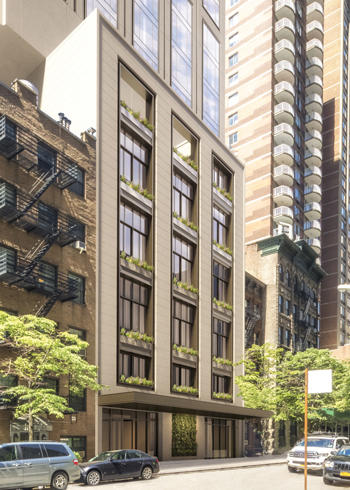Trending
New York’s vertical problem
A look at what makes it so difficult to build a “megatall,” as other cities continue to eclipse the NYC skyline

If completed, the world’s tallest building would stand not in the center of a global capital, but in an empty, sprawling development plot in a Saudi Arabian port city.
The Jeddah Tower is expected to rise 3,281 feet, usurping Dubai’s Burj Khalifa by more than 200 feet. It’s also intended to be the first piece of a massive, 57 million-square-foot megadevelopment — like a more remote and arid Hudson Yards, and more than double the size. Though the tower’s construction was reportedly interrupted in February, following a government-led anti-corruption crackdown that involved two of the project’s main backers — Prince Al-Waleed bin Talal and Bakr bin Laden, the chairman of the project’s general contractor, Bin Laden Group — the project shows the scale of construction possible when building with few to no restrictions. At last check, the tower had reached 853 feet.
“In Jeddah, we’re in the middle of nowhere,” said Robert Sinn, principal at structural engineering consulting firm Thornton Tomasetti, who is working on the tower. “In some ways, that becomes a blank piece of paper for the architects.”
Building in New York City is dramatically different, of course. The process can take several years, in some cases well over a decade, as owners navigate fluctuations in the market, the city’s byzantine building regulations and fierce public opposition. The city isn’t yet home to a “megatall,” a term used by the Council on Tall Buildings and Urban Habitat to describe structures that exceed 1,968 feet. One World Trade Center is as close as it gets in New York. And at 1,792 feet, it’s the seventh tallest among completed buildings worldwide.
Reasons for New York’s lagging status are myriad. The prevailing obstacles to breaking the 2,000-foot threshold include the city’s strict and protean zoning regulations. Compounding this is the fact that land is scarce, and amassing the necessary development rights can be both time-consuming and costly. What’s more, the city’s housing shortage doesn’t leave much political appetite for using such structures to boost density.
“It’s becoming more and more difficult to go up that high. The city spent the last number of years getting rid of the higher-density zones,” said Michael Stern, the CEO of JDS Development Group. “It’s not impossible, but I don’t think you are going to see a 2,000-foot building in New York anytime soon.”
Status symbol
Building on desert sand is arguably more difficult than on bedrock, the material found beneath much of Midtown and Lower Manhattan. The deepest point of the Jeddah foundation is nearly 400 feet, Sinn said, while most New York foundations usually stop well short of 150 feet below grade.
But building tall is less about the soil and more about status, according to Stephen DeSimone, president of his eponymous engineering firm, DeSimone Consulting Engineers.

A rendering of Sutton 58
“If you don’t have a supertall building, you can’t be a ‘first city,’” he said. “It has very little to do with if you’re building on bedrock or sand.”
Such towers can also serve as a catalyst for further development. In Saudi Arabia, Jeddah Tower isn’t expecting to make money on its own, Sinn said, but rather from the apartments, offices and hotels that rise around it, which will collectively go by the name Jeddah Economic City. He said the Burj Khalifa had a similar business plan.
“All [the Burj Khalifa’s residential] units sold out, but they still lost money,” he said. “But they are making gobs of money on the buildings around it.”
In New York, the construction of colossal towers is less aspirational, DeSimone said. Private developers aren’t driven to build supertalls in order to cement the city’s global prestige — they are building what makes financial sense. For instance, the market for luxury condos is soft. So while some developers are moving forward with massive condo high-rises, including Extell Development with its 1,550-foot-tall Central Park Tower, it’s unlikely that others will endeavor to build higher in the near term.
And in terms of office buildings, while a panoramic view from a staggering height might be appealing to tenants, the kind of space created at such altitudes often isn’t.
“There aren’t that many office tenants that are interested in very small floor plates and very long trips to and from their offices,” said Paul Selver, co-chair of Kramer Levin’s land use group.
Elevator needs, too, would likely deter developers from building any higher, according to Moses Gates, vice president for housing and neighborhood planning with the city planning-focused nonprofit Regional Planning Association (RPA).
“In terms of office buildings, I feel like recent construction and historical construction have shown that you maybe get up to 1,500 feet,” he said. “[Otherwise] you start to just need a ridiculous number of elevators.”
Not to mention that construction is far cheaper everywhere else than New York. The city is the most expensive place in the world to build, costing an average of $362 per square foot, according to Turner & Townsend’s 2018 international construction market survey. Meanwhile, in Shanghai, home to the world’s second-tallest building (for now) at 2,073 feet, that number is $75 per square foot. The average cost of construction in United Arab Emirates — home to the Burj Khalifa — is $135 per square foot.
There’s also the matter of One World Trade Center. The tower’s height is symbolic, and developers seem hesitant to be the first to exceed it. Back in 2015, several media outlets reported that the spire of Extell’s Central Park Tower would dethrone the office building by one foot. This turned out to be false but showed the frenzy such a prospect could create.
Separately, living and working at such high altitudes may not always appeal to potential buyers and renters, especially post-Sept. 11 terrorist attacks, said Richard Jantz, who leads Cushman & Wakefield’s project and development services group.
“There’s a demographic of people that don’t want to sleep on the 192nd floor,” he said. “People are still, in the deep depths of their psyche, a little frightened of going that high.”
Staying power
Over the last few years, major technological advancements have enabled buildings to climb even higher. At least 187 towers surpassing 820 feet are expected to rise globally in the next two years alone, according to Bloomberg. This is made possible, in part, by increased strength of concrete and technology that helps control movement of these slim towers. Buildings are incorporating concrete with as much as 14,000 pounds per square inch compressive strength. Tuned mass dampers — which can take the form of a giant pendulum at the top of the building — help stop towers from swaying in the wind. Elevator companies are also racing to dream up the best way to travel in these structures, like Germany-based ThyssenKrupp, which has been working on an elevator that can move vertically and horizontally.

But in New York, other obstacles stand in the way. Because Manhattan is an island, buildings must be designed with the transportation of construction materials in mind. The steel used for Related Companies and Oxford Property Group’s Hudson Yards, for example, was designed so it could be delivered by ship and across bridges. Additionally, the tight constraints of development sites limit what kind of construction material can be stored and what can be transported down narrow side streets.
The size of a lot also severely restricts what can be built on it. The maximum development allowed on a site is determined by multiplying the lot’s size by a city-determined floor area ratio (FAR). With the exception of Midtown East — which was recently rezoned — and Hudson Yards, most of the zoning in the city doesn’t exceed 15 or 16 FAR.
The RPA has supported recent efforts in Albany to lift a cap on the size of residential buildings, which limits floor area ratios at 12. Gates said the legislation — which didn’t make it past the state Senate’s rules committee before the end of the session — is about adding more apartments to buildings. But critics argue that too many buildings are “architecturally imposing” without adding significant amounts of new housing.
“Opposition to this is just, ‘This means a building is going to be twice as high,’ which is completely untrue,” Gates said.
As a result of such regulation, assembling the necessary development rights for towers that exceed their FAR takes time and often requires cutting deals with several different parties, including city officials and neighboring property owners. By the time a developer has amassed the necessary building rights for a project, the market for that particular asset type might be soft.
Holding onto a site for an extended period of time doesn’t just pose financial risks, Selver said. The city’s zoning regulations are anything but static, and neighborhood groups have increasingly taken action against projects they deem out of character with the neighborhood.
For example, construction of a planned 800-foot tower, on the Upper East Side, Sutton 58, was halted for several months after a local group — with the support of the local City Council member — secured a rezoning of the area that would restrict the building’s height. Gamma Real Estate, the project’s developer, won an exemption from the rezoning in late June after taking its case to the Board of Standards and Appeals. Still, the opposition group, the East River 50s Alliance, plans to file a lawsuit to stop the project. Similar efforts to stop another project on the Upper East Side, DDG’s 521-foot-tall 188 East 88th Street, and one on the Upper West Side at SJP Properties and Mitsui Fudosan’s 668-foot-tall 200 Amsterdam Avenue.
“It’s very, very time-consuming,” Selver said. “You have to have real staying power, and there aren’t that many developers that have that.”




